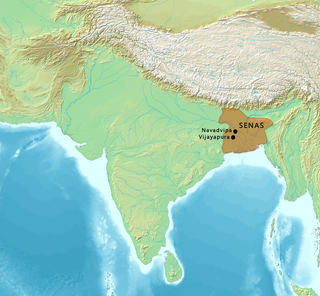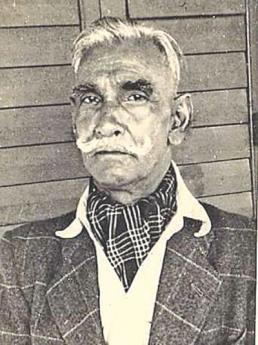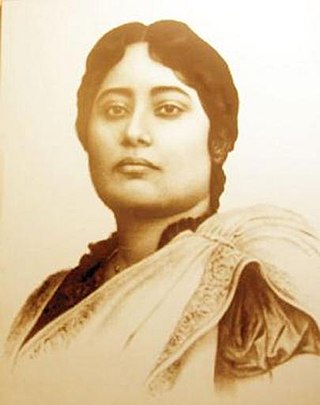Nauratan/Navaratnas or Nauratan was a term applied to a group of nine extraordinary people in an emperor's court in India. The well-known Navaratnas include the ones in the courts of the legendary emperor Vikramaditya, the 16th-century Mughal emperor Akbar, and the 18th-century feudal lord Raja Krishnachandra.

The Gita Govinda is a work composed by the 12th-century Hindu poet, Jayadeva. It describes the relationship between Krishna, Radha and gopis of Vrindavan.

The Sena dynasty was a Hindu dynasty during the early medieval period on the Indian subcontinent, that ruled from Bengal through the 11th and 12th centuries. The empire at its peak covered much of the north-eastern region of the Indian subcontinent. The rulers of the Sena Dynasty traced their origin to the south Indian region of Karnataka.

The history of Bengal is intertwined with the history of the broader Indian subcontinent and the surrounding regions of South Asia and Southeast Asia. It includes modern-day Bangladesh and the Indian states of West Bengal, Tripura and Assam's Karimganj district, located in the eastern part of the Indian subcontinent, at the apex of the Bay of Bengal and dominated by the fertile Ganges delta. The region was known to the ancient Greeks and Romans as Gangaridai, a powerful kingdom whose war elephant forces led the withdrawal of Alexander the Great from India. Some historians have identified Gangaridai with other parts of India. The Ganges and the Brahmaputra rivers act as a geographic marker of the region, but also connects the region to the broader Indian subcontinent. Bengal, at times, has played an important role in the history of the Indian subcontinent.

Durga Mohan Das was a Brahmo Samaj leader and a social reformer.
The birthplace of the twelfth-century Sanskrit poet Jayadeva, author of the Gitagovinda, has been disputed, with the neighboring states of Odisha, West Bengal in eastern India and the region of Mithila staking a claim. This had led to a bitter feud between people on both sides that lasted for over a century. The issue is still debated by scholars.

Surendranath College is an undergraduate college affiliated to the University of Calcutta, in Kolkata, India. It was founded in 1884 by the nationalist leader and scholar Surendranath Banerjee. It offers undergraduate and postgraduate level courses in various arts, commerce and science subjects.

Godagari is an Upazila of Rajshahi District in the Division of Rajshahi, Bangladesh. This is the place where Mahananda river fall to Padma or Ganges.

The culture of Bengal defines the cultural heritage of the Bengali people native to eastern regions of the Indian subcontinent, mainly what is today Bangladesh and the Indian states of West Bengal and Tripura, where they form the dominant ethnolinguistic group and the Bengali language is the official and primary language. Bengal has a recorded history of 1,400 years. After the partition, Bangladeshi culture became distinct from the mainstream Bengali culture, thus their culture evolved differently, still there are many commonalities in Bangladeshi culture & West Bengali culture which connects them both together as Bengali culture.
Dhoyin or Dhoyī was a 12th century Sanskrit-language poet who composed the Pavanadūta. He was a court poet of the Sena king Lakshmana Sena, who ruled Gauda in what is now Bengal.
Brajabuli is an artificial literary language popularized by the Maithili poet Vidyapati. His Brajabuli lyrics about the love for Radha Krishna is considered to his best of works. Other poets emulated his writing, and the language became established in the 16th century. Among the medieval Bengali poets who wrote in Brajabuli are Narottama Dasa, Balarama Das, Jnanadas, and Gobindadas Kabiraj.
Lokkhon Sen or Lakshman Sena was the ruler from the Sen dynasty of the Bengal region on the Indian subcontinent. His rule lasted for 28 years.
Ballāla Sena or Ballal Sen, also known as Ballal Sen in vernacular literature, was the second ruler of the Sena dynasty of Bengal region of the Indian subcontinent. He was the son and successor of Vijaya Sena, and ended the Pala Empire by defeating Govinda Pala.

Syed Abdus Samad was an Indian football player from Bengal. Dubbed "Football Jadukor", he played for India national football team in 1924 and captained it in 1926. He played as a forward.
The Deopara Prashasti is a stone inscription (prashasti) eulogizing the Sena kings of Bengal. It was composed by Umapati Dhara, a minister in the court of Lakshmana Sena, who was also one of several court poets. The inscription particularly praises Lakshmana Sena's grandfather Vijaya Sena. The alphabet is a precursor of the modern Bengali alphabet, with 22 letters approximating the modern forms. The stone tablet was found in 1865 near the village of Deopara, now in Godagari Upazila of Rajshahi District of modern-day Bangladesh. This inscription described that Sena king Bijay Sen is the real founder of the Sena Empire.

Manindra Nath Nayak was a Bengali revolutionary and Indian independence activist.
Fanindranath Gooptu mostly known as F.N. Gooptu was an Indian industrialist. He led manufacturing of writing instruments such as fountain pens with an indigenous process, pencils, nips of fountain pens, ink etc. His own company F. N. Gooptu & Co. was situated at the Beliaghata region of Kolkata, India.

Mrinalini Devi was a translator and the wife of Nobel laureate poet, philosopher, author and musician Rabindranath Tagore. She was from the Jessore district, where her father worked at the Tagore estate. In 1883, at the age of nine, she married Tagore.

Uddharan Dutta Thakur (উদ্ধারণ দত্ত ঠাকুর) was an Indian philosopher and saint from the Gaudiya Vaishnava school of Vedanta tradition, producing a great number of philosophical works on the theology and practice of Bhakti yoga, Vaishnava Vedanta and associated disciplines. He is known as one of the Dwadasha gopas,.

Deopara Prashasti described the founder of Sena dynasty Samanthasena, as a migrant Brahmaksatriya from Karnataka. The epithet 'Brahma-Kshatriya' suggests that Senas were Brahmins by caste who took the profession of arms and became Kshatriyas. The Sena kings were also probably Baidyas, according to historian P.N. Chopra.










